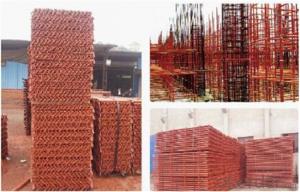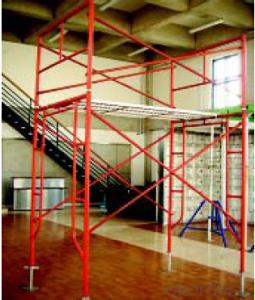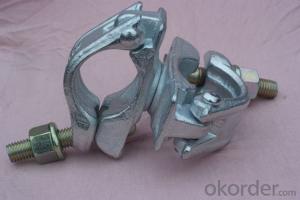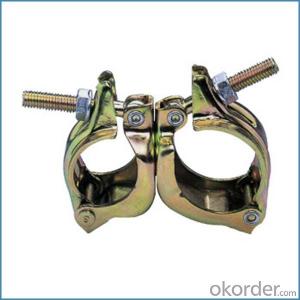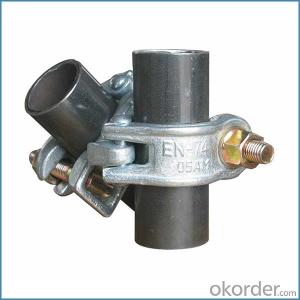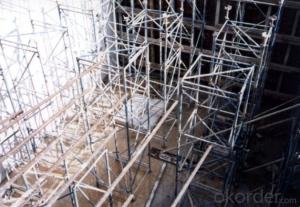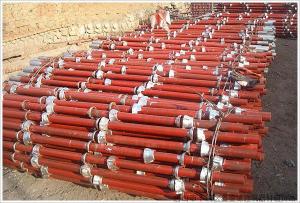Coupler Bolt Clamp Bolt Eye Bolt Scaffolding British Type for Sale
- Loading Port:
- Tianjin
- Payment Terms:
- TT OR LC
- Min Order Qty:
- 1000 kg
- Supply Capability:
- 100000 kg/month
OKorder Service Pledge
OKorder Financial Service
You Might Also Like
Coupler Bolt Clamp Bolt Eye Bolt Scaffolding British Type for Sale
Description
1.The scaffolding coupler is always used to connect the steel pipe as scaffolding system.
2.The often used coupler is swivel coupler and righ angle coupler .
3.We can provide types of scaffolding coupler according to your requirement.
4.Couoler can fix the 48.3mm scaffolding steel pipe tightly and make the whole scaffolding system more steadily.
5.Material:Q235 steel
6.Overall Size:48.3mm*48.3mm
7.Surface Finish: Galvanized/ Painted
8.Standard:BS1139,EN74
9.Package:25pcs/bag
10.Manufactuering as per customer requirements

Feature
(1)Excellent Anti-Breaking—Cold Pressed Steel
(2)Outstanding Resistance Deformation
(3)Strong Anti-Dropping Ability
(4)Longtime USe
(5)Qualtity Guaranteed
(6)OEM Service
Photo



Parameter
| Material | Q235,345steel |
| Size | 48.3mm*48.3mm |
| Surface finish | Galvanized |
| Weight | 1.1kg around |
| Standard | BS1139,EN74 |
| Package | 25pcs/bag,steel pallet |
| Manufacture | As per customer requirement |
| Market | Africa, South America, the Middle East and Asia |
FAQ
Q: Are you a factory or trading company?
We are a state-owned corporation in China,dealing with various kinds of building materials.We have our holding subsidiaries.
Q: Where is your factory located? How can I visit there?
Our factory is located all around China.
Q: Can I get some samples?
Sample is free, customer only pay freight for the first time.
Q: Delivery?
10-30days. (5-15 containers)
Any question,feel free to contact us.
- Q: Can steel tube couplers be used in scaffolding projects with extreme temperatures?
- Steel tube couplers can be used in scaffolding projects with extreme temperatures, but it is important to consider the specific conditions and requirements of the project. Steel is known for its strength and durability, making it a suitable material for scaffolding in various environments. However, extreme temperatures can affect the performance and integrity of steel. In cold temperatures, steel can become brittle, which may increase the risk of cracking or fracturing. It is essential to ensure that the couplers used in scaffolding projects are made from high-quality steel that is specifically designed to withstand low temperatures. Additionally, regular inspections and maintenance should be conducted to identify any potential issues and prevent failures. In hot temperatures, steel can expand, which may lead to loosening or deformation of the couplers. It is crucial to choose couplers that are designed to handle high temperatures and provide proper expansion allowance. This will help to maintain the stability and integrity of the scaffolding structure. Overall, while steel tube couplers can generally be used in scaffolding projects with extreme temperatures, it is important to consider the specific conditions and select appropriate couplers that are designed to withstand the temperature extremes. Consulting with experts and following manufacturer guidelines can help ensure the safety and effectiveness of scaffolding projects in extreme temperature environments.
- Q: What is the purpose of a steel tube coupler in scaffolding?
- The purpose of a steel tube coupler in scaffolding is to securely connect and join steel tubes together, providing stability and strength to the overall scaffolding structure.
- Q: Are steel tube couplers easy to dismantle and remove from scaffolding?
- Yes, steel tube couplers are generally easy to dismantle and remove from scaffolding. They are designed to be easily adjustable and can be quickly disconnected without the need for specialized tools. The couplers are typically secured with bolts or pins, which can be easily loosened or removed to disconnect the tubes. This allows for efficient dismantling of the scaffolding structure when it is no longer needed. Additionally, the couplers are made from durable materials such as steel, which ensures their stability and longevity while also facilitating easy removal.
- Q: What is the lifespan of steel tube couplers in scaffolding?
- The lifespan of steel tube couplers in scaffolding can vary depending on several factors. Generally, high-quality steel tube couplers are designed to withstand heavy loads and provide long-lasting support. With proper maintenance and regular inspection, steel tube couplers can have a lifespan of 10 to 15 years or more. However, it is essential to consider the environmental conditions and the intensity of use. Exposure to extreme weather conditions, such as heavy rain, snow, or corrosive elements, can accelerate the deterioration of steel tube couplers. Likewise, if the scaffolding is frequently dismantled and reassembled, the constant wear and tear may shorten the lifespan of the couplers. Regular inspections, including checking for signs of corrosion, cracks, or deformation, are crucial to ensuring the safety and reliability of steel tube couplers. If any damage or deterioration is detected, it is essential to replace the couplers immediately to maintain the integrity of the scaffolding structure. Ultimately, the lifespan of steel tube couplers in scaffolding depends on factors such as the quality of the couplers, environmental conditions, and maintenance practices. By following proper care and conducting regular inspections, it is possible to maximize the lifespan of steel tube couplers and ensure the safety of the scaffolding structure.
- Q: Can steel tube couplers be used in scaffolding systems with non-standard tube sizes?
- Steel tube couplers are typically designed for use with standard tube sizes, which adhere to specific industry standards and dimensions. These couplers are manufactured to provide a secure and reliable connection between scaffolding tubes. Using steel tube couplers with non-standard tube sizes can be problematic and potentially unsafe. The couplers might not fit properly or securely on the non-standard tubes, leading to a weak connection that could compromise the stability and structural integrity of the scaffolding system. It is always recommended to use couplers that are specifically designed and manufactured for the specific tube sizes being used in a scaffolding system. This ensures a proper fit, secure connection, and compliance with safety regulations. If non-standard tube sizes are being used, it is advisable to consult with a scaffolding expert or engineer to determine the best course of action and obtain appropriate couplers that are compatible with the unique tube sizes.
- Q: How do steel tube couplers perform in areas with high vibration or impact loads?
- Steel tube couplers are designed to perform exceptionally well in areas with high vibration or impact loads. The robust construction and durability of steel allow these couplers to withstand the intense forces exerted by vibrations or impacts without compromising their functionality or structural integrity. This makes them a reliable and effective solution for applications in such demanding environments.
- Q: Are steel tube couplers compatible with both steel and aluminum scaffolding?
- Steel tube couplers are compatible with steel scaffolding but not with aluminum scaffolding. Steel tube couplers are specifically designed to connect steel tubes and provide a secure and stable connection. The dimensions and threading of steel tube couplers are specifically made to fit steel tubes. Aluminum scaffolding, on the other hand, has different dimensions and threading, which means that steel tube couplers will not provide a proper fit or a secure connection when used with aluminum scaffolding. Therefore, it is crucial to use the appropriate couplers that are specifically designed for aluminum scaffolding to ensure safety and stability.
- Q: What are the common industry standards for the safe use of steel tube couplers in scaffolding?
- The common industry standards for the safe use of steel tube couplers in scaffolding can vary depending on the country or region. However, there are some widely recognized standards that provide guidelines for the safe use of steel tube couplers in scaffolding systems. One of the most prominent standards is the EN 74-1:2005 standard, issued by the European Committee for Standardization (CEN). This standard specifies the requirements for steel tube couplers used in scaffolding, including their design, materials, dimensions, and performance. It also provides instructions for the safe use and maintenance of these couplers. In the United States, the Occupational Safety and Health Administration (OSHA) sets regulations and standards for the safe use of scaffolding, including steel tube couplers. OSHA's scaffolding standards can be found in 29 CFR 1926 Subpart L, which outlines requirements for the design, construction, and use of scaffolds, including the use of couplers. Other countries may have their own specific standards for the safe use of steel tube couplers in scaffolding. For example, the British Standards Institution (BSI) has published a series of standards known as the BS 1139 series, which provide guidelines for the use of scaffolding, including couplers, in the UK. These standards generally emphasize the importance of using high-quality, properly designed and manufactured couplers that are suitable for the specific application and load requirements. They also highlight the need for proper inspection, maintenance, and training to ensure the safe use of steel tube couplers in scaffolding systems. It is crucial for individuals and companies involved in scaffolding operations to be aware of and comply with the applicable industry standards and regulations to ensure the safety of workers and the general public.
- Q: Can steel tube couplers be used for scaffolding systems with high wind loads?
- Yes, steel tube couplers can be used for scaffolding systems with high wind loads. Steel tube couplers are designed to provide a secure and stable connection between scaffolding tubes, ensuring the structural integrity of the system. They are made from strong and durable steel, which makes them capable of withstanding high wind loads. Additionally, steel tube couplers are usually manufactured to meet industry standards and regulations, ensuring their reliability in challenging conditions. However, it is crucial to consider other factors such as proper design, installation, and bracing of the scaffolding system, as well as adherence to local regulations and safety guidelines, to ensure the stability and safety of the scaffolding in high wind conditions.
- Q: How are steel tube couplers used in scaffolding?
- Steel tube couplers are used in scaffolding to connect two or more tubes together, creating a stable and secure structure. These couplers are designed to firmly hold the tubes in place, allowing for the construction of scaffolding platforms, walkways, and support structures. They play a crucial role in ensuring the safety and stability of the scaffolding system, providing a reliable connection between the tubes and preventing any movement or separation.
Send your message to us
Coupler Bolt Clamp Bolt Eye Bolt Scaffolding British Type for Sale
- Loading Port:
- Tianjin
- Payment Terms:
- TT OR LC
- Min Order Qty:
- 1000 kg
- Supply Capability:
- 100000 kg/month
OKorder Service Pledge
OKorder Financial Service
Similar products
Hot products
Hot Searches







